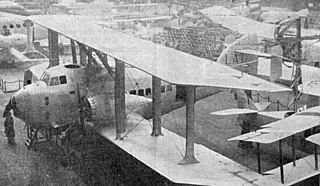Related Research Articles

The Roe IV Triplane was an early British aircraft designed by Alliott Verdon Roe and built by A.V. Roe and Company. It was first flown in September 1910.

The Avro Type D was an aircraft built in 1911 by the pioneer British aircraft designer A.V. Roe. Roe had previously built and flown several aircraft at Brooklands, most being tractor layout triplanes. The Type D was his first biplane.

The Avro Type E, Type 500, and Type 502 made up a family of early British military aircraft, regarded by Alliott Verdon Roe as his firm's first truly successful design. It was a forerunner of the Avro 504, one of the outstanding aircraft of the First World War.

The Bristol Gordon England biplanes were a series of early British military biplane aircraft designed by Eric Gordon England for the Bristol Aeroplane Company that first flew in 1912. Designed for easy ground transport, the aircraft could be quickly disassembled.

The Handley Page Type G was a two-seat British biplane, designed by Handley Page that first flew in 1913. Only one was built.

The Latécoère 4 was a three-engined, 15-passenger biplane built in France in the early 1920s. It proved difficult to fly and was discontinued, though a second machine was completed as the Latécoère 5 bomber.
The Surrey Flying Services AL.1 was a single-engined side-by-side two-seat training biplane, built at a UK flying club in 1929. Only one was built, but it was flying until the outbreak of war in 1939 and remains in storage.

The Dunne D.8 of 1912 was a tailless swept wing biplane, designed by J. W. Dunne to have inherent stability. One example was supplied to RAE Farnborough. License-built Burgess-Dunne models were used by the US Signal Corps and United States Navy and the short-lived Canadian Aviation Corps. It was the latter's first and only warplane.
The Perry Beadle T.1 was a single-seat, single engine biplane built and flown in the United Kingdom in 1913. In 1914 it flew with a more powerful engine and other modifications as the Perry Beadle T.2, which was acquired by the Royal Navy Air Service at the outbreak of World War I.

The ASL Viking was a single-engined two seater biplane aircraft designed and built by Horatio Barber's Aeronautical Syndicate Ltd. at Hendon. It was first flown in January 1912.

The Cody Michelin Cup Biplane was an experimental aircraft designed and built in Britain during 1910 by Samuel Franklin Cody, a prominent showman and aviation pioneer. Cody had worked with the British Army on experiments with man-lifting kites and in October 1908 had successfully built and flown the British Army Aeroplane No 1, making the first officially verified powered flight in the United Kingdom. Cody broke the existing endurance record twice in the aircraft, the second flight, made on 31 December 1910, winning him the Michelin Cup for the longest-lasting flight made over a closed circuit in the United Kingdom before the end of the year.

The Paalson Type 1, (Pålson), was a Swedish single-seat sport aircraft built around 1920. It was of conventional single-seat biplane layout but had some unusual features such as girder type interplane struts, a novel main undercarriage axle mounting and a mechanism allowing adjustment of the angle of incidence of the upper wing.

The Spijker, Spyker V.1 or Spyker-Trompenburg V.1, was a single seat biplane fighter built in the Netherlands during World War I. It was underpowered and did not go into production.

The Van Meel Brikken was an early Dutch Farman type biplane. Three were built, one being the first Dutch military aircraft and another the first Dutch water-borne one. Two were used by the Dutch Army Aircraft Division as trainers.

The LFG Roland G.I was a large prototype single-engine biplane bomber built in Germany in 1915, during World War I. It had a single engine buried in the fuselage driving pusher configuration propellers mounted on outriggers.

The LFG Roland Pfeilflieger, (Arrow-flyer), was a German swept wing, single engine, two seat biplane built in Germany in 1914. It made one distinguished long duration flight and served in colonial German South-West Africa.

The Paulhan biplane was a French experimental aircraft designed in 1910 by the successful aviator Louis Paulhan in collaboration with Henri Fabre. The prototype became the second aircraft bought by the British War Office: two further examples, differing in constructional detail, were built.

The Caudron C.74 was a ten-seat, four engine passenger biplane built in France in 1922. It showed promise but the sole prototype crashed fatally in a competition and no more were completed.
The Caudron Type B was a 1911 development of the earliest Caudron type, the Caudron Type A, with a nacelle style fuselage and more powerful engine. Initially an equal span biplane, it was modified into a sesquiplane.
Kawanishi's first aircraft, the Kawanishi K-1, was designed as a mail carrier. It was the first Japanese aircraft to receive a Certificate of Airworthiness from the Aviation Bureau. It won a prize in a national contest but was not a commercial success and only one was built.
References
- 1 2 3 4 5 6 Goodall, Michael H.; Tagg, Albert E. (2001). British Aircraft before the Great War. Atglen, PA, USA: Schiffer Publishing Ltd. p. 123. ISBN 0-7643-1207-3.
- 1 2 3 4 5 Aspin, Chris (1988). Dizzy Heights - The Story of Lancashire's First Flying Men. Helmshore Local History Society. pp. 103–6. ISBN 0-906881-04-8.
- ↑ "Southport aerodrome". Flight . No. 1 July 1911. p. 572.
- ↑ "Southport aerodrome". Flight . No. 8 July 1911. p. 592.
- ↑ "Southport aerodrome". Flight . No. 15 July 1911. p. 611.
- ↑ "Southport aerodrome". Flight . No. 29 July 1911. p. 663.
- ↑ "Southport aerodrome". Flight . No. 12 August 1911. p. 698.
- ↑ "Southport aerodrome". Flight . No. 9 September 1911. p. 786.
- ↑ "Southport aerodrome". Flight . No. 16 September 1911. p. 805.